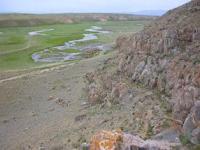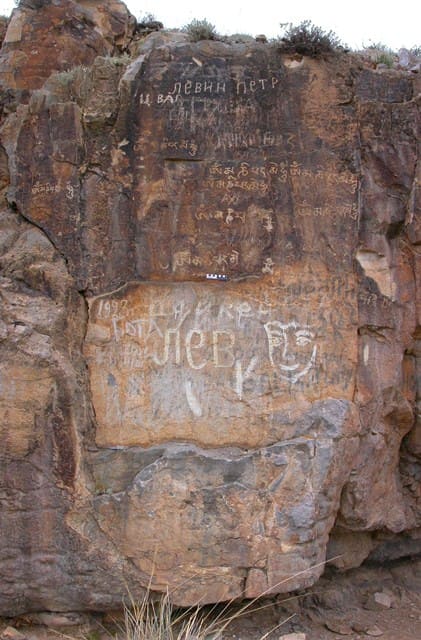You are here
Buddhist inscriptions Kegen arasan.

Buddhist inscriptions in Almaty region.
“In the bluish distance, where the last visible hill merged with the fog, nothing moved; the guard and burial mounds, which rose here and there above the horizon and the boundless steppe, looked stern and dead; centuries and complete indifference to man were felt in their stillness and soundlessness; Another thousand years will pass, billions of people will die, and they will still stand as they stood, not at all sorry for the dead, not interested in the living, and not a single soul will know why they are standing and what secret of the steppe they are hiding under them."
A.P. Chekhov. "Happiness". Dedicated to Ya.P. Polonsky.
Petroglyphs in Kegen district of Almaty region.
Buddhist inscriptions Kegensky arasan are located at an altitude of 1850 meters above sea level in the southern spurs of the Temirlik mountains, 690 meters northeast of the right bank of the Kegen River, in the Rayymbek district of the Alamata region.
Buddhist inscriptions are located 7.3 kilometers southwest of the village of Aktasty, which is part of the Tasashinsky rural district, 7.2 kilometers southeast of the center of the village of Kegen. The first scientific description of the monument was prepared in 1859 by A. Golubev, photographs of two planes with inscriptions and a description of the monument in 1900 were made by N.N. Pantusov.
In the course of a stubborn struggle in the middle of the 17th century, the Oirats ousted the tribes of the Kazakhs of the Senior Zhuz and the Tien Shan Kyrgyz from the left bank of the Ili River, and already in the 1660s. moved their camps to the foothills of the Trans-Ili and Kirghiz Alatau.
In the late 90s of the 17th century, the Khuntaiji Tsevan-Rabdan moved his headquarters (urgu) from South Tarbagatai and Dzhungar Alatau to the upper reaches of the Ili River and its tributaries Sharyn and Khorgos, as well as to the Tekes River valley.
Since that time, the active settlement of the highland valleys of Kegen, Karkara, Tekes and the eastern coast of Lake Issyk-Kul by the Oirats-Lamaists began. Along with the construction of irrigation facilities, fortresses, temples and monasteries (sume, or sumba), traces of which still exist here today, miraculous sanctuaries arose, similar to the Kegen arasan.
The early stage of the functioning of the monument at the end of the 17th - the first half of the 18th centuries may include texts written in the “clear writing” of the Oirats, and part of the Tibetan six-syllable mantras “om-ma-ni pad-me hum” (“Oh! The pearl in the lotus flower!” ), addressed to Avalokiteshvara, a bodhisattva personified by the Dalai Lama and embodying infinite compassion, a prayer to the Buddhas for care and protection over all living beings.
With the defeat of the Dzungar Khanate by Chinese troops in 1755-1757, the Kegen and Karkara valleys were again occupied by the Kyrgyz tribes, who shared summer pastures here with the Kazakhs of the Senior Zhuz, who settled in the foothill valleys of the left bank of the Ili River.
After the approval of the Russian-Chinese border along the Tien Shan, the administrative-territorial structure of the Semirechensk region underwent changes in 1882, and the lands along the Kegen, Karkara and Tekes rivers, formerly occupied by the Kyrgyz, completely went to the nomadic Kazakh-Albans of the Dzharkent district.
Apparently, the Alzhan-Alaman tamga on the main plane with inscriptions near the Kegen Arasan, recorded in a photograph by N. N. Pantusov, dates back to the time of this internal demarcation and a long struggle for the best wintering between the Albanian clans, Kyrgyz and Kalmyks.
Description of monument Buddhist inscriptions Kegen arasan.
Tibetan and Oirat inscriptions are carved on 7 planes on a rock not far from the spring, revered as a healing spring. On a vertical rock (plane, square 1) there are 9 identical Tibetan inscriptions, below and above the inscriptions - "1923 Alexei Levin", "Pyotr Levin".
The source itself is located 10 - 15 meters to the west of site 1 and lower in level. On the rock above it there are modern inscriptions (female and male names) from the 1970s - 2000s. In the spring near the rocks there are offerings of pilgrims: coins, whole and broken pieces of jewelry, clothes, gilded watches, a large stone from a ring, etc.
Coins - USSR (1970 - 1980), Kazakhstan (1990 - 2000s geg ), 1 pfennig Germany 1981. Judging by the dates of the visits and the composition of the offerings, the spring broke through here from under the rock relatively recently, about thirty years ago or a little earlier.
But 20 meters to the right, you can see deep niches washed out in the rock, indicating the place of the ancient mouth of the spring, when the level of groundwater feeding it was 1.5 meters higher than today. It is above these niches that there is a wide rocky surface (pl. 1), covered with black “desert tan”, on which 9 ancient Tibetan inscriptions and many modern “autographs” are engraved. The inscriptions contain the same prayer spell; all signs are the same values are made in a similar way, as if with one hand.
Above and below the inscriptions, the names of certain Peter and Alexei Levins, dated 1923, are large-cut. Apparently, the spring functioned at this place as early as the first third of the 20th century. To the right (east) of the rock panel there are 6 more surfaces with similar inscriptions.
In total, there are seven planes with inscriptions on the Arasan rocks; three of them contain epigraphic texts made in the Oirat script, in the remaining cases, this is a Tibetan spell “om-mani-pad-me-hum” reproduced 20 times.
At the same time, the signs of the Tibetan script are twice applied over the earlier Oirat inscriptions. The largest text, which includes 7 or 8 vertical lines, is heavily damaged by chips, including those formed when a Tibetan mantra was beaten out over them.
According to the translation by N. S. Yakhontova (IVR RAS, St. Petersburg, Russia), the Oirat inscription on the second plane reads Zam baγši bičiji bosxoboi “Written by the teacher Zam”. On the last stone, the Tibetan line "Om-ma-ni pad-me-hum" overlaps several vertical Oirat inscriptions of the same content.
The inscriptions of the Kegen arasan were created in several stages over a long period. On the main plane, judging by the photograph of N.N. Pantusov in 1900, there is (unfortunately, today this section of the rock is heavily damaged by modern graffiti) a large image of a tamga-shaped sign in the form of a circle with three long rays extending in different directions, scratched below the inscriptions.
Tamga was marked on the rock obviously later than the inscriptions and belongs to one of the clans of the Alban Kazakh tribe of the Elder Zhuz - Alzhan (Alaman branch), whose representatives inhabit this part of the Kegen valley at the present time. The time of applying the tamga is between 1882 and 1900.
Local legend (recorded in 2008 by employees of the historical and ethnographic expedition of the Kazakh Research Institute of Cultural Heritage of Nomads of the Ministry of Culture and Culture of the Republic of Kazakhstan in the village of Aktasty) says that the arasan has a mistress, Kereke-kisi, who guards the purity of the source and sometimes appears to pilgrims in the guise of a ninety-year-old gray-haired woman dressed in white clothes and always accompanied by a white camel; they say that she appears by the stream at dawn, takes a bath and prays here until noon.
People come here to heal bodily and mental ailments, stay overnight, perform prayers and ablutions. Sick cattle are also specially brought to the arasan and watered in the lower reaches of the stream, not letting them go to the source (bastau), where they try to maintain cleanliness.
Geographical coordinates of Buddhist inscriptions Kegen arasan: N42°59'34.14" E79°18'52.59"

Authority:
Pantusov N. N. "Kurtynyn-Kapchagay and Dzhalpak-tas (Kurtinskaya Volost, Vernensky Uyezd)". PTKLA. Year IV. Tashkent. 1899. C.62-67.
ogozhinsky A.E. “We, who have applied the true tamgas below ...” (the experience of identifying tribal signs of the Kazakhs of the Senior Zhuz). The role of nomads in the formation of the cultural heritage of Kazakhstan. Scientific readings in memory of N. E. Masanov: collection of materials of the international scientific conference. Almaty: Print-S, 2010. P. 101 - 127.
Rogozhinsky A.E. "Kegensky arasan". From Altai to the Caspian. Atlas of monuments and sights of nature, history and culture of Kazakhstan. T.2. Almaty, 2011, pp. 153 – 161.
Composer's personal information. A.E. Rogozhinsky, Candidate of Historical Sciences, Leading Researcher of the Research and Restoration Laboratory "Crimea Island", Almaty.
Photos by
A.E. Rogozhinsky. 2008







